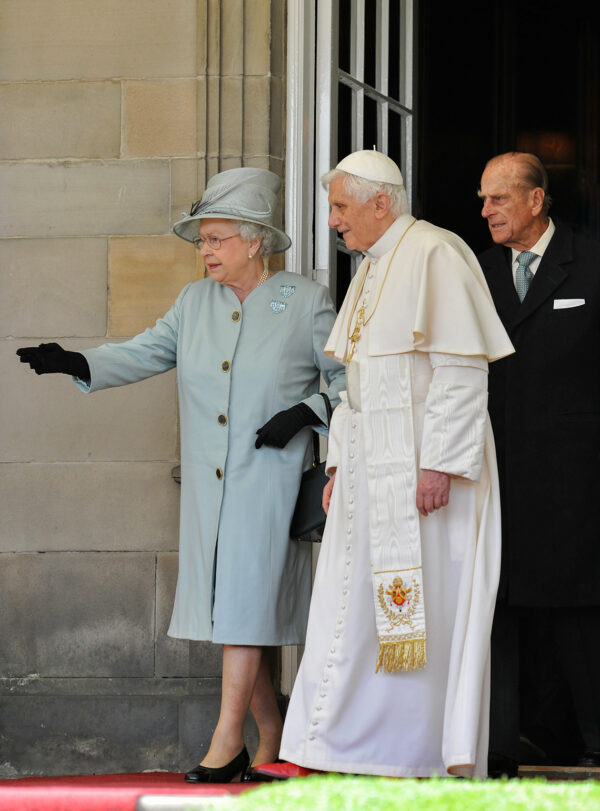His Royal Highness Prince Philip, Duke of Edinburgh, was a man of intense personal as well as open faith. Perhaps his role in advocating religious understanding can be seen in the context of his continuing support for his wife as Fidei Defensor – Defender of the Faith – a role that every British monarch has held since the establishment of the Anglican faith; given his support for a dialogue between the faiths of Christianity and in promoting inter-religious dialogue.
In a parliamentary tribute to the Prince, the Archbishop of Canterbury remembered the tradition of newly appointed diocesan bishops being asked to preach at Sandringham. “Prince Philip listened intently, thought deeply, and over lunch interrogated knowingly. His reading theologically was wide, his memory retentive, his analysis perceptive” (1). He was baptised into the Orthodox Church in Greece, where he lived for the first 18 months of his life before he converted to the Anglican faith in 1947, upon marrying Princess Elizabeth. It is of note that his mother, Princess Alice of Battenberg, became a Greek Orthodox nun and was buried beside her aunt, the Grand Duchess Elisabeth (Ella), canonised as a Russian Orthodox saint, in the Church of St Mary Magdalen on the Mount of Olives in Jerusalem. He experienced an intensification of faith relatively late in life. The British journalist Giles Milton wrote in The Spectator in 1992 that Prince Philip, then 70, had revived his interest in Orthodox Christianity and held meetings with several Orthodox prelates, including the Russian Orthodox bishop for Great Britain and Ireland, Metropolitan Anthony Bloom. He was a regular visitor to Mount Athos, Eastern Orthodox Church religious sanctuary. A supporter of Jewish causes, he was the first British royal to visit Israel in 1994, traveling as a private citizen to attend a ceremony honouring his mother as “Righteous Among the Nations” by Yad Vashem, for saving the lives of the members of the Cohen family. Currently, the Prince is worshipped by a small sect in the Pacific Islands in a tiny village of the small nation of Vanuatu, the locals have long revered Prince Philip as a divine being, based on a prophecy that a mountain spirit’s peripatetic son would one day return to the island in the company of his powerful wife (2,3). Among Prince Philip’s most notable achievements was the founding of the St. George’s House in 1966, together with the then Dean of Windsor, Robin Woods, as part of the College of St George, whose heart is St George’s Chapel, where senior members of government, commerce, academia and charities can meet in the atmosphere of privacy and confidentiality of the walls of Windsor Castle, for discussions of contemporary issues of common interest. Its website quotes that „St George’s Chapel is where prayer is offered for the nation three times a day, every day. That tradition of prayer, established in 1348 by King Edward III, has extended for more than six hundred years. It is precisely this tradition that gives the House its impetus and its wider theological context” (4). In 1986, Prince Philip as a President of the World Wildlife Fund (WWF), was instrumental in global change by organising a meeting in the Basilica of St. Francis in Assisi, where the leaders of the five major world religions – Buddhism, Christianity, Hinduism, Islam and Judaism and leading environmental bodies gathered together to discuss how their faiths could help save the natural world. A special invitation: „Come, proud of your own tradition, but humble enough to learn from others”, which applied as much to the secular environmental organisations as it did to the great faiths, was issued. As a result of this gathering The Assisi Declaration on Nature was published. By 1995 when the Alliance of Religions and Conservation was formed, the five initial faiths had issued more detailed statements, and six other significant world faiths had also made their statements.
Subsequently, this led to the creation of a programme, Faith Commitments for a Living Planet which was launched at Windsor Castle in 2009 with the UN Secretary-General Ban Ki-Moon, which has profoundly shaped the faiths’ response to the environment over the last decade. Prince Phillip was a great supporter of the John Templeton Foundation and presented the Templeton Prize, a lucrative award for contribution to life’s spiritual dimension, for nearly 40 years. He demonstrated a keen interest in every Laureate, asking thoughtful and well-informed questions.
He presented the first award to Mother Teresa of Calcutta in a ceremony held at London’s historic Guildhall in 1973, and continued to participate in a private ceremony for each prize-winner held at Windsor Castle or Buckingham Palace. Professor Michal Heller, Roman Catholic priest, cosmologist and Professor in the Faculty of Philosophy at the Pontifical Academy of Theology in Krakow received the Templeton Prize from Prince Philip in Buckingham Palace in May 2008 for his research in reconciling the known scientific world with the unknown dimensions of God.
The Queen received condolences from Pope Francis, the Archbishop of Canterbury, the Archbishop of Westminster, the Chief Rabbi Ephraim Mirvis, The Muslim Council of Britain, the Hindu Council UK, the Sikh Federation UK and other churches of all denominations as well as religions. According to the Vatican News (5) Pope Francis expressed his condolences to the Queen through his Secretary of State, Cardinal Pietro Parolin. “Saddened to learn of the death of your husband Prince Philip, Duke of Edinburgh, His Holiness Pope Francis offers heartfelt condolences to Your Majesty and the members of the royal family. Recalling Prince Philip’s devotion to his marriage and family, his distinguished record of public service and his commitment to the education and advancement of future generations, His Holiness commends him for the merciful love of Christ our Redeemer,” the Cardinal wrote. “Upon you and upon all who grieve his loss in the sure hope of the resurrection, the Holy Father invokes the Lord’s blessings of consolation and peace” he concluded. The Archbishop of Westminster Cardinal Vincent Nichols, speaking on 10 April at a Requiem Mass for Prince Philip he prayed for the repose of his soul and said: “Every family in grief needs comfort and support, and none more so than a grieving wife, our Queen. May our prayers contribute to her comfort and support” (6). Indeed, Christian Churches of many denominations held services to remember Prince Philip as they reflected on a man whose outspoken exterior hid a strong personal faith and deep intellectual curiosity about others’ beliefs (7). It is a fair assumption that many friends were among the fellow mourners who connected to the Queen’s sadness as a wife grieving a devoted husband of 73 years, who had been in her own words ‚her rock’. According to the publication in Church Times (8), at the Prince’s Parliamentary Tribute at the House of Lords, the former Bishop of Oxford, Lord Harries, praised Prince Philip for his interfaith work, specifically the foundation of the Alliance of Religions and Conservation (ARC), and the Interfaith Declaration: A Code of Ethics on International Business for Christians, Muslims, and Jews, launched on 25 May 1994 at St. James’s Palace. “Prince Philip clearly had a keen interest in religion, and I understand that his personal library was absolutely chock-full of books on religions of one kind or another,” he said.“However, it is his public role to which we pay tribute here, where we know that he wanted to make a difference. He saw that one way of doing that was by helping religious institutions relate better to one another through their senior lay people.” It is important to note that the Alliance of Religions and Conservation was established to assist the major religions of the world to develop environmental programs based on their own core teachings, beliefs and practices.
He was a choreographer of his own funeral arrangements and the service at St. George’s Chapel on 17 April, included words from the Book of Common Prayer, but also nods to the Roman Catholic Church and to the Orthodox tradition. The choice of the First Reading from the Old Testament Book of Ecclesiasticus alluded to his belief that humankind should serve God through responsible stewardship of the Earth.
Given his support for a dialogue between the two denominations of Christianity, it was not surprising that Prince Philip and the Queen visited the Vatican State on several occasions helping bring the two Christian faiths ever closer. In 1951, the year before she was enthroned, the then Princess Elizabeth and Prince Philip met Pope Pius XII. Several visits followed: As queen, she met Pope John XXIII at the Vatican in 1961 and in 1965 and Pope John Paul II at the Vatican in 1980 and 2000. The year 1961 was the first time that a reigning British monarch visited a pope in 400 years. The year 1980 demonstrated a significant change of course in relations with the Vatican (8). During that meeting she welcomed the Pope’s plan to visit Great Britain and the couple were to meet Pope John Paul again in 1982 in Buckingham Palace during his pastoral visit to the UK and in the Vatican in October 2000 at her state visit. Historically, Pope John Paul II had travelled to the UK in 1982 for a six-day pastoral tour during which he greeted and blessed thousands of people at 16 different venues. It was the first time that a pope had visited Britain in more than 400 years (11)
In 2010, Prince Philip representing the Queen, greeted Pope Benedict at Edinburgh International Airport at the beginning of his four-day state visit to the UK. According to WBUR (13), the pontiff was greeted by the sound of bagpipers upon his arrival in Scotland, where he met with Queen Elizabeth II and Prince Philip on the first stop of his four-day visit. Pope Benedict, sporting a green tartan scarf, travelled through the capital city of Edinburgh in his armoured Popemobile, greeted by a crowd of about 125,000 well-wishers. The Queen, who is both head of state and head of the Church of England, told Pope Benedict during their meeting at the Holyrood Palace that his visit reminded all Britons of their common Christian heritage. She said she hoped relations between the Anglican Church and the Catholic Church would be deepened as a result.” We know from experience that through committed dialogue, old suspicions can be transcended and a greater mutual trust encouraged,” the Queen said. “We hold that freedom to worship is at the core of our tolerant and democratic society. „Pope Benedict said the queen’s forefathers’ „respect for truth and justice, for mercy and charity come to you from a faith that remains a mighty force for good in your kingdom.” At an open-air mass in Bellahouston Park, Glasgow, Pope Benedict spoke to an audience of over 60,000. „As we reflect on the sobering lessons of atheist extremism of the 20th century, let us never forget how the exclusion of God, religion and virtue from public life leads ultimately to a truncated vision of man and of society and thus a reductive vision of a person and his destiny,” (12). Perhaps these noteworthy and historic visits to the UK by both Pope John Paul II and Pope Benedict XVI can be seen as a proof of the success of decades of diplomacy between the two denominations of Christianity spearheaded by the Royal Couple. There is little doubt that Prince Philip contributed hugely to the enduring success of Vatican-British relations.
On the Queen and Prince Philip’s 2014 visit to the Vatican, The Duke of Edinburgh met Pope Francis for the first and last time (9). During their 20-minute meeting, Prince Philip received three papal medals: gold, silver and bronze, the prince thanked him, joking, „It’s the only gold medal I’ve ever won.” Clearly, his sense of humour seldom failed him. The Pope presented the couple with a facsimile of Pope Innocent XI’s order extending the cult of St. Edward the Confessor. St. Edward, King of England in the mid-11th century, is venerated by both Catholics and Anglicans. The Pope also gave the royal couple a blue lapis-lazuli orb decorated with a silver cross for their then eight-month-old great-grandson Prince George. The orb is an emblem of royal power which the ancient Romans used to represent the universe, before it was adapted by Christians who added a cross on top to represent the world under Christianity. They presented the famously frugal pontiff with a wicker hamper of British food which included honey, apple juice, 12 eggs, and rib of beef from the royal estates as well as a bottle of Balmoral Whiskey. The meeting was described as a private one and pomp and protocol were kept to a minimum. In a break with Vatican convention, the Queen did not wear black, or a veil, but instead wore a lilac-coloured spring coat and matching hat. This visit marking the 100th anniversary of the re-establishment of diplomatic relations demonstrated „the importance that she places on this relationship with the Holy See and on getting to know Pope Francis,” said Nigel Baker, the British ambassador to the Holy See (10).
Prince Philip’s life experience and his role as a Consort placed him in a unique position of religious understanding and influence. It would not be at all surprising that history might accord him significantly more than a footnote for his well-served role of promoting faith and religious understanding. The Queen and Prince Philip’s achievements in bridging the 400 years rift between England and the Holy See are evidently noteworthy. It is important to remember the frequently reported warmth between the Popes and Queen Elizabeth and Prince Philip and to remark on the gifts between Pope Francis and the couple were not signs of formal, diplomatic gifts between leaders but more of a sign of friendship between people of faith.
The Prince’s accomplishments in the realm of religion were notably abundant if not popularly publicised – as is often the case with men of personal merit. In many ways he was a proponent of religious dialogue and a man whose personal beliefs in the divinely ordained duty of man over the Earth inspired his views on the importance of Conservation and environmental causes.
His Royal Highness Prince Philip, a man of many independent though often strident opinions, cynical dry wit, restless energy, intellectual curiosity, was at last recognised as a devout Christian, as a gentleman and officer, environmentalist and person of substance who gave the Queen, Great Britain, the Commonwealth and civil society worldwide so much.
Unprecedented tributes of the British people and particularly of the British media, often so hostile towards Prince Philip through his life, were proof that the country began to recognise his true value with grateful hearts.
Halina, Countess of Munster
References:
1. Church Times https://www.churchtimes.co.uk/articles/2021/16-april/news/uk/peers-remember-prince-philip-s-lifelong-dedication-and-profound-faith
2. Religious News https://religionnews.com/2021/04/09/anglican-convert-and-pacific-island-deity-five-faith-facts-about-prince-philip/
3. The Tablet https://www.thetablet.co.uk/texts-speeches-homilies/4/1765/obituary-hrh-the-prince-philip-duke-of-edinburgh
4.The Tablet https://www.thetablet.co.uk/texts-speeches-homilies/4/1765/obituary-hrh-the-prince-philip-duke-of-edinburgh
5. Vatican News https://www.vaticannews.va/en/pope/news/2021-04/pope-francis-condolence-telegram-prince-philip-elizabeth-parolin.html
6. The Tablet https://www.thetablet.co.uk/news/14033/pope-sends-heartfelt-condolences-to-queen
7. The Independent https://www.independent.co.uk/news/religious-leaders-recall-prince-philips-spiritual-curiosity-philip-elizabeth-ii-justin-welby-churches-archbishop-b1829757.html
8.Church Times https://www.churchtimes.co.uk/articles/2021/16-april/news/uk/peers-remember-prince-philip-s-lifelong-dedication-and-profound-faith)
9. BBC https://www.bbc.com/news/av/uk-17586062
10. Rome Reports (https://www.romereports.com/en/2021/04/09/the-duke-of-edinburgh-and-the-popes/
11. National Catholic Reporter https://www.ncronline.org/news/vatican/pope-britains-queen-elizabeth-have-informal-meeting-vatican
12. The Guardian https://www.theguardian.com/world/gallery/2010/sep/06/pope-uk-visit-1982
13. WBUR (https://www.wbur.org/npr/129902338/story.php
14. CBC News https://www.cbc.ca/news/world/pope-holds-open-air-mass-in-glasgow-1.942032)
















